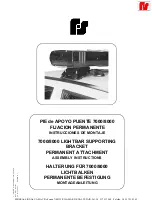
22
5 Mounting
VEGAPULS 6X • Two-wire 4 … 20 mA/HART
66190-EN-221107
1
Fig. 17: Position of the polarisation
1 Nose for marking the direction of polarisation
ÍÊÆÁÆ¿ÌÀ½ÀÇÍËÁÆ¿»À¹Æ¿½ËÌÀ½ÈÇĹÊÁ˹ÌÁÇƹƼÌÀÍ˹ÄËÇÌÀ½½Ű½»Ì
of false echoes on the measured value.
Note:
Therefore, pay attention to the position of the polarisation when
mounting or when making subsequent changes. Fix the housing to
prevent a change in the metrological properties (see chapter "
Hous-
ing features
").
Radar sensors emit their measurement signal in the form of a beam.
Depending on the distance and antenna size (beam angle), a meas-
ÍʽŽÆ̹ʽ¹Ç¾¼ÁŰ½Ê½ÆÌËÁҽʽËÍÄÌËƓ˽½Ì¹ºÄ½º½ÄÇÏƕ
4)
Presentation Distance
Diameter of the measurement surface de-
pending on the antenna size (beam angle)
G¾, ¾ NPT
(14°)
G1½,
1½ NPT (7°)
80 mm, 3"
(3°)
1 m
0.25 m
0.12 m
0.05 m
2 m
0.5 m
0.25 m
0.1 m
3 m
0.75 m
0.25 m
0.15 m
5 m
1.2 m
0.35 m
0.25 m
8 m
2 m
1 m
0.4 m
10 m
2.4 m
1.2 m
0.5 m
20 m
4.8 m
2.4 m
1 m
30 m
7.25 m
3.5 m
1.5 m
When mounting the device, keep a distance of at least 200 mm
(7.874 in) from the vessel wall. If the device is installed in the center
of dished or round vessel tops, multiple echoes can arise. However,
these can be suppressed by an appropriate adjustment (see chapter
"
Setup
").
Note:
If you cannot maintain this distance, you should carry out a false
signal suppression during setup. This applies especially if buildup on
the vessel wall is to be expected.
5)
Measuring surface
Mounting position -
liquids
4)
The measurement surface is the area with the highest energy of the radar
signal.
5)
In this case, it is recommended to repeat the false signal suppression at a
later time with existing buildup.
















































